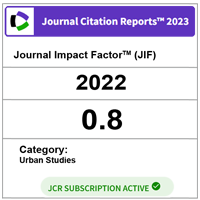Indoor Thermal Environment of Various Semi-Enclosed Atrium Configurations of Institutional Building in Tropical Climate
DOI:
https://doi.org/10.11113/ijbes.v8.n2.710Keywords:
Atrium, Configurations, Indoor thermal environment, Tropical climateAbstract
The consideration of local climate is essential for the application of atrium in building. Different strategies and approaches in atrium configuration are required for different climates in ensuring its effectiveness. Nevertheless, the final aim is still similar which is to provide a comfortable environment for the users. Hence, this study was executed to examine the effects of top and side configurations on the indoor thermal environment of semi-enclosed atrium in the tropical climate. The methodologies involved field measurement and questionnaire survey. The field measurements were executed at two different configurations of semi-enclosed atriums in the tropical climate of Malaysia. Meanwhile, the questionnaire surveys were executed simultaneously with the field measurements in obtaining the users’ thermal sensation and satisfaction. The findings indicated that the top configuration had more influence to the indoor thermal environment compared to the side configuration as it determined the amount of solar heat penetration into the atrium area. Meanwhile, the side configuration influenced the air velocity inside the atrium. The Faculty of Engineering and Built Environment’s atrium that has opaque top finishes was found to have the average indoor operative temperature of less than 30 °C throughout the day, though the average outdoor air temperature was more than 30 °C. It also had more hours with neutral thermal sensation felt by the users compared to the Faculty of Economics and Management’s atrium that has transparent materials for the top finishes. The study is useful in guiding the selection of appropriate strategy for an atrium in tropical climate
References
Abdullah, A. H., Meng, Q., Zhao, L., & Wang, F. (2009). Field study on indoor thermal environment in an atrium in tropical climates. Building and Environment, 44(2), 431–436. https://doi.org/10.1016/j.buildenv.2008.02.011
Abdullah, A. H., & Wang, F. (2012). Design and low energy ventilation solutions for atria in the tropics. Sustainable Cities and Society, 2(1), 8–28. https://doi.org/10.1016/j.scs.2011.09.002
Acosta, I., Varela, C., Molina, J. F., Navarro, J., & Sendra, J. J. (2018). Energy efficiency and lighting design in courtyards and atriums: A predictive method for daylight factors. Applied Energy, 211, 1216–1228. https://doi.org/10.1016/j.apenergy.2017.11.104
Acred, A., & Hunt, G. R. (2014). Stack ventilation in multi-storey atrium buildings: A dimensionless design approach. Building and Environment, 72, 44–52. https://doi.org/10.1016/j.buildenv.2013.10.007
Adams, A., Theodore, D., Goldenberg, E., McLaren, C., & McKeever, P. (2010). Kids in the atrium: Comparing architectural intentions and children’s experiences in a pediatric hospital lobby. Social Science and Medicine, 70, 658–667. https://doi.org/10.1016/j.socscimed.2009.10.049
Aldawoud, A. (2013). The influence of the atrium geometry on the building energy performance. Energy and Buildings, 57, 1–5. https://doi.org/10.1016/j.enbuild.2012.10.038
Aldawoud, A., & Clark, R. (2008). Comparative analysis of energy performance between courtyard and atrium in buildings. Energy and Buildings, 40(3), 209–214. https://doi.org/10.1016/j.enbuild.2007.02.017
Asfour, O. S. (2020). A comparison between the daylighting and energy performance of courtyard and atrium buildings considering the hot climate of Saudi Arabia. Journal of Building Engineering, 30, 101299. https://doi.org/10.1016/j.jobe.2020.101299
ASHRAE. (2017). ANSI/ASHRAE Standard 55-2017: Thermal Environmental Conditions For Human Occupancy. Atlanta.
Brager, G. S., & Dear, R. J. de. (1998). Thermal adaptation in the built environment: a literature review. Energy and Buildings, 27, 83–96.
Chu, G., Sun, Y., Jing, T., Sun, Y., & Sun, Y. (2017). A Study on Air Distribution and Comfort of Atrium with Radiant Floor Heating. Procedia Engineering, 205, 3316–3322. https://doi.org/10.1016/j.proeng.2017.10.345
Curl, J. S. (2006). Oxford Dictionary of Architecture and Landscape Architecture (Second). Oxford: Oxford University Press.
Daghigh, R. (2015). Assessing the thermal comfort and ventilation in Malaysia and the surrounding regions. Renewable and Sustainable Energy Reviews, 48, 681–691. https://doi.org/10.1016/j.rser.2015.04.017
Djamila, H., Chu, C. M., & Kumaresan, S. (2013). Field study of thermal comfort in residential buildings in the equatorial hot-humid climate of Malaysia. Building and Environment, 62, 133–142. https://doi.org/10.1016/j.buildenv.2013.01.017
Ghasemi, M., Noroozi, M., Kazemzadeh, M., & Roshan, M. (2015). The influence of well geometry on the daylight performance of atrium adjoining spaces: A parametric study. Journal of Building Engineering, 3, 39–47. https://doi.org/10.1016/j.jobe.2015.06.002
GoogleMap. (2020). Google Map. Retrieved from https://www.google.com/maps/place/Universiti+Kebangsaan+Malaysia
He, Y., Liu, M., Kvan, T., & Peng, S. (2017). An enthalpy-based energy savings estimation method targeting thermal comfort level in naturally ventilated buildings in hot-humid summer zones. Applied Energy, 187, 717–31. https://doi.org/10.1016/j.apenergy.2016.11.098
Huang, X., Ma, X., & Zhang, Q. (2019). Effect of building interface form on thermal comfort in gymnasiums in hot and humid climates. Frontiers of Architectural Research, 8(1), 32–43. https://doi.org/10.1016/j.foar.2018.11.002
Huang, Y., Borong, L., Yao, N., & Yingxin, Z. (2015). Functional Relationship between Lighting Energy Consumption and the Main Parameters for Double Atrium Offices. Procedia Engineering, 121, 1869–1879. https://doi.org/10.1016/j.proeng.2015.09.169
Humphreys, M. A., Rijal, H. B., & Nicol, J. F. (2013). Updating the adaptive relation between climate and comfort indoors; new insights and an extended database. Building and Environment, 63, 40–55. https://doi.org/10.1016/j.buildenv.2013.01.024
Hung, W. Y. (2003). Architectural aspects of atrium. International Journal on Engineering Performance-Based Fire Codes, 5(4), 131–137.
Hung, W. Y., & Chow, W. K. (2001). A review on architectural aspects of atrium buildings. Architectural Science Review, 44(3), 285–295. https://doi.org/10.1080/00038628.2001.9697484
Hussain, S., & Oosthuizen, P. H. (2012). Numerical investigations of buoyancy-driven natural ventilation in a simple atrium building and its effect on the thermal comfort conditions. Applied Thermal Engineering, 40, 358–372. https://doi.org/10.1016/j.applthermaleng.2012.02.025
Hussain, S., & Oosthuizen, P. H. (2013). Numerical investigations of buoyancy-driven natural ventilation in a simple three-storey atrium building and thermal comfort evaluation. Applied Thermal Engineering, 57, 133–146. https://doi.org/10.1016/j.applthermaleng.2013.03.033
Hwang, R. L., Lin, T. P., & Kuo, N. J. (2006). Field experiments on thermal comfort in campus classrooms in Taiwan. Energy and Buildings, 38(1), 53–62. https://doi.org/10.1016/j.enbuild.2005.05.001
Jorgensen, M., Iversen, A., & Jensen, L. B. (2012). Investigation of architectural strategies in relation to daylight and integrated design- a case study of three libraries in Denmark. Journal of Green Building, 7(1), 40–54. https://doi.org/10.3992/jgb.7.1.40
Lau, S. S. Y., Zhang, J., & Tao, Y. (2019). A comparative study of thermal comfort in learning spaces using three different ventilation strategies on a tropical university campus. Building and Environment, 148, 579–599. https://doi.org/10.1016/j.buildenv.2018.11.032
López-Pérez, L. A., Flores-Prieto, J. J., & Ríos-Rojas, C. (2019). Adaptive thermal comfort model for educational buildings in a hot-humid climate. Building and Environment (Vol. 150). Elsevier Ltd. https://doi.org/10.1016/j.buildenv.2018.12.011
Lu, Y., Xiang, Y., Chen, G., Wu, Y., Sun, C., & Liu, J. (2019). Summer dynamic thermal environment for isolated atrium in the severe cold region: On-site measurement and numerical simulation. Applied Thermal Engineering, (160), 114108. https://doi.org/10.1016/j.applthermaleng.2019.114108
Mishra, A. K., & Ramgopal, M. (2014). Thermal comfort in undergraduate laboratories - A field study in Kharagpur, India. Building and Environment, 71, 223–232. https://doi.org/10.1016/j.buildenv.2013.10.006
Mohsenin, M., & Hu, J. (2015). Assessing daylight performance in atrium buildings by using Climate Based Daylight Modeling. Solar Energy, 119, 553–560. https://doi.org/10.1016/j.solener.2015.05.011
Sharples, S., & Lash, D. (2007). Daylight in atrium buildings: A critical review. Architectural Science Review, 50(4), 301–312. https://doi.org/10.3763/asre.2007.5037
Song, K. D. (2007). Influence of canopy systems on daylight performance of four-sided atria under an overcast sky. Indoor and Built Environment, 16(2), 110–120. https://doi.org/10.1177/1420326X07077953
Tabesh, T., & Sertyesilisik, B. (2016). An investigation into energy performance with the integrated usage of a courtyard and atrium. Buildings, 6(2), 1–20. https://doi.org/10.3390/buildings6020021
Taleghani, M., Tenpierik, M., & van den Dobbelsteen, A. (2014). Energy performance and thermal comfort of courtyard/atrium dwellings in the Netherlands in the light of climate change. Renewable Energy, 63, 486–497. https://doi.org/10.1016/j.renene.2013.09.028
Toe, D. H. C., & Kubota, T. (2013). Development of an adaptive thermal comfort equation for naturally ventilated buildings in hot-humid climates using ASHRAE RP-884 database. Frontiers of Architectural Research, 2(3), 278–291. https://doi.org/10.1016/j.foar.2013.06.003
Vethanayagam, V., & Abu-Hijleh, B. (2019). Increasing efficiency of atriums in hot, arid zones. Frontiers of Architectural Research, 8, 284–302. https://doi.org/10.1016/j.foar.2019.05.001
Wang, L., Huang, Q., Zhang, Q., Xu, H., & Yuen, R. K. K. (2017). Role of atrium geometry in building energy consumption: The case of a fully air-conditioned enclosed atrium in cold climates, China. Energy and Buildings, 151, 228–241. https://doi.org/10.1016/j.enbuild.2017.06.064
Yusoff, W. F. M., Sulaiman, M. K. A. M., & Muhsin, F. (2019). Preliminary evaluation of air flow in atrium of building in hot and humid climate. International Journal of Sustainable Tropical Design Research and Practice, 12(1), 43–52.
Downloads
Published
How to Cite
Issue
Section
License
Copyright (c) 2021 International Journal of Built Environment and Sustainability

This work is licensed under a Creative Commons Attribution-NonCommercial-ShareAlike 4.0 International License.
Copyright of articles that appear in International Journal of Built Environment and Sustainability belongs exclusively to Penerbit Universiti Teknologi Malaysia (Penerbit UTM Press). This copyright covers the rights to reproduce the article, including reprints, electronic reproductions or any other reproductions of similar nature.
Authors who publish with this journal agree to the following terms:
- This Journal applies Creative Commons Licenses of CC-BY-NC-SA
- Authors retain copyright and grant the journal right of publication with the work simultaneously licensed under a Creative Commons Attribution License that allows others to share the work with an acknowledgement of the work's authorship and publication in this journal.
- Authors are able to enter into separate, additional contractual arrangements for the non-exclusive distribution of the journal's published version of the work (e.g., post it to an institutional repository or publish it in a book), with an acknowledgement of its publication in this journal.
- Authors are permitted and encouraged to post their work online (e.g., in institutional repositories or on their website) prior to and during the submission process, as it can lead to productive exchanges, as well as earlier and greater citation of published work (See The Effect of Open Access).








